y
l
n
O
r
e
n
t
r
a
P
P
A
S
e
s
U
l
a
n
r
e
t
n
I
BC400
Introduction to the ABAP
Workbench
SAP NetWeaver
Date
Training Center
Instructors
Education Website
Participant Handbook
CourseVersion:2006/Q2
CourseDuration:5Days
Material Number: 50078658
An SAP course - use it to learn, reference it for work
I
n
t
e
r
n
a
l
U
s
e
S
A
P
P
a
r
t
n
e
r
O
n
l
y
�
Copyright
Copyright ' 2006 SAP AG. All rights reserved.
No part of this publication may be reproduced or transmitted in any form or for any purpose without the
express permission of SAP AG. The information contained herein may be changed without prior notice.
Some software products marketed by SAP AG and its distributors contain proprietary software
components of other software vendors.
Trademarks
Microsoftfi, WINDOWSfi, NTfi, EXCELfi, Wordfi, PowerPointfi and SQL Serverfi are
registered trademarks of Microsoft Corporation.
IBMfi, DB2fi, OS/2fi, DB2/6000fi, Parallel Sysplexfi, MVS/ESAfi, RS/6000fi, AIXfi, S/390fi,
AS/400fi, OS/390fi, and OS/400fi are registered trademarks of IBM Corporation.
ORACLEfi is a registered trademark of ORACLE Corporation.
INFORMIXfi-OnLine for SAP and INFORMIXfi Dynamic ServerTM are registered trademarks
of Informix Software Incorporated.
UNIXfi, X/Openfi, OSF/1fi, and Motiffi are registered trademarks of the Open Group.
Citrixfi, the Citrix logo, ICAfi, Program Neighborhoodfi, MetaFramefi, WinFramefi,
VideoFramefi, MultiWinfi and other Citrix product names referenced herein are trademarks of
Citrix Systems, Inc.
HTML, DHTML, XML, XHTML are trademarks or registered trademarks of W3Cfi, World Wide
Web Consortium, Massachusetts Institute of Technology.
JAVAfi is a registered trademark of Sun Microsystems, Inc.
JAVASCRIPTfi is a registered trademark of Sun Microsystems, Inc., used under license for
technology invented and implemented by Netscape.
SAP, SAP Logo, R/2, RIVA, R/3, SAP ArchiveLink, SAP Business Workflow, WebFlow, SAP
EarlyWatch, BAPI, SAPPHIRE, Management Cockpit, mySAP.com Logo and mySAP.com are
trademarks or registered trademarks of SAP AG in Germany and in several other countries all
over the world. All other products mentioned are trademarks or registered trademarks of their
respective companies.
Disclaimer
THESE MATERIALS ARE PROVIDED BY SAP ON AN "AS IS" BASIS, AND SAP EXPRESSLY
DISCLAIMS ANY AND ALL WARRANTIES, EXPRESS OR APPLIED, INCLUDING WITHOUT
LIMITATION WARRANTIES OF MERCHANTABILITY AND FITNESS FOR A PARTICULAR
PURPOSE, WITH RESPECT TO THESE MATERIALS AND THE SERVICE, INFORMATION, TEXT,
GRAPHICS, LINKS, OR ANY OTHER MATERIALS AND PRODUCTS CONTAINED HEREIN. IN
NO EVENT SHALL SAP BE LIABLE FOR ANY DIRECT, INDIRECT, SPECIAL, INCIDENTAL,
CONSEQUENTIAL, OR PUNITIVE DAMAGES OF ANY KIND WHATSOEVER, INCLUDING
WITHOUT LIMITATION LOST REVENUES OR LOST PROFITS, WHICH MAY RESULT FROM
THE USE OF THESE MATERIALS OR INCLUDED SOFTWARE COMPONENTS.
y
l
n
O
r
e
n
t
r
a
P
P
A
S
e
s
U
l
a
n
r
e
t
n
I
I
n
t
e
r
n
a
l
U
s
e
S
A
P
P
a
r
t
n
e
r
O
n
l
y
�
y
l
n
O
r
e
n
t
r
a
P
P
A
S
e
s
U
l
a
n
r
e
t
n
I
About This Handbook
This handbook is intended to complement the instructor-led presentation of this
course, and serve as a source of reference. It is not suitable for self-study.
Typographic Conventions
American English is the standard used in this handbook. The following typographic
conventions are also used.
Type Style
Example text
Example text
EXAMPLE TEXT
Example text
Example text
Description
Words or characters that appear on the screen. These
include field names, screen titles, pushbuttons as well as
menu names, paths, and options.
Also used for cross-references to other documentation
both internal (in this documentation) and external (in
other locations, such as SAPNet).
Emphasized words or phrases in body text, titles of
graphics, and tables
Names of elements in the system. These include report
names, program names, transaction codes, table names,
and individual key words of a programming language,
when surrounded by body text, for example SELECT
and INCLUDE.
Screen output. This includes file and directory names
and their paths, messages, names of variables and
parameters, and passages of the source text of a program.
Exact user entry. These are words and characters that
you enter in the system exactly as they appear in the
documentation.
Variable user entry. Pointed brackets indicate that you
replace these words and characters with appropriate
entries.
2006/Q2
' 2006 SAP AG. All rights reserved.
iii
I
n
t
e
r
n
a
l
U
s
e
S
A
P
P
a
r
t
n
e
r
O
n
l
y
�
y
l
n
O
r
e
n
t
r
a
P
P
A
S
e
s
U
l
a
n
r
e
t
n
I
About This Handbook
BC400
Icons in Body Text
The following icons are used in this handbook.
Icon
Meaning
For more information, tips, or background
Note or further explanation of previous point
Exception or caution
Procedures
Indicates that the item is displayed in the instructor’s
presentation.
iv
' 2006 SAP AG. All rights reserved.
2006/Q2
I
n
t
e
r
n
a
l
U
s
e
S
A
P
P
a
r
t
n
e
r
O
n
l
y
�
y
l
n
O
r
e
n
t
r
a
P
P
A
S
e
s
U
l
a
n
r
e
t
n
I
Contents
Course Overview ............................................................................. vii
Course Goals.................................................................................vii
Course Objectives ...........................................................................vii
Unit 1: Flow of an ABAP Program ..........................................................1
System Architecture and ABAP Program Using Example of Selection Screen and
List ..........................................................................................2
Unit 2: Introduction to the ABAP Workbench.......................................... 17
Repository and Object Navigator ......................................................... 18
Developing Programs and Organizing Developments ................................. 29
Unit 3: Introduction to the ABAP Dictionary ........................................... 65
Data Modeling and Descriptive Elements in the ABAP Dictionary ................... 66
Unit 4: Basic ABAP Language Elements................................................ 87
Working with Elementary Data Objects.................................................. 88
Working with Structures................................................................... 115
Working with Internal Tables .............................................................128
Unit 5: Data Retrieval .......................................................................159
Reading Database Tables ................................................................160
Authorization Check .......................................................................188
Unit 6: Tools for Program Analysis......................................................207
Runtime Analysis and Code Inspector..................................................208
Unit 7: Subroutines in ABAP .............................................................223
Subroutines.................................................................................224
Unit 8: Introduction to ABAP Events ...................................................247
ABAP Events ...............................................................................248
2006/Q2
' 2006 SAP AG. All rights reserved.
v
I
n
t
e
r
n
a
l
U
s
e
S
A
P
P
a
r
t
n
e
r
O
n
l
y
�
y
l
n
O
r
e
n
t
r
a
P
P
A
S
e
s
U
l
a
n
r
e
t
n
I
Contents
BC400
Unit 9: User dialogs.........................................................................259
List ...........................................................................................261
Selection Screen...........................................................................283
Screen.......................................................................................303
User Interface ..............................................................................349
ABAP Web Dynpro (Outlook) ............................................................369
Unit 10: Reuse Components ..............................................................385
Working with Function Modules..........................................................386
Working with Methods.....................................................................404
Working with BAPIs .......................................................................424
Unit 11: Adjusting the SAP Standard Software (Overview)........................435
Adjusting the SAP Standard Software (Overview) ....................................436
Index............................................................................................453
vi
' 2006 SAP AG. All rights reserved.
2006/Q2
I
n
t
e
r
n
a
l
U
s
e
S
A
P
P
a
r
t
n
e
r
O
n
l
y
�
y
l
n
O
r
e
n
t
r
a
P
P
A
S
e
s
U
l
a
n
r
e
t
n
I
Course Overview
This course introduces you to the ABAP programming language of SAP as well
as its development environment, the ABAP Workbench. In both cases, we will be
focusing on concepts and fundamental principles. We also introduce the appropriate
terminology, so that you will find it easier to understand follow-on documentation.
We always handle these topics using practical application examples so that you can
immediately implement what you have learned here. Above all, it should become clear
how little effort is required to rapidly create high-performance business applications in
the ABAP Workbench.
We are convinced that this course will enable you to start developing immediately
and provide you with the knowledge needed to focus on the essentials in subsequent
courses.
That is why this course is a prerequisite for more in-depth ABAP Workbench
programming courses.
Target Audience
This course is intended for the following audiences:
Project team members
ABAP programmers
Course Prerequisites
Required Knowledge
Programming knowledge
SAPTEC (SAP NetWeaver Basics of the Application Platform)
Course Goals
This course will prepare you to:
Understand and use basic ABAP syntax elements
Implement different types of user dialog
Program read accesses to the database
Use the ABAP Workbench development tools
Understand how developments are organized and transported
2006/Q2
' 2006 SAP AG. All rights reserved.
vii
I
n
t
e
r
n
a
l
U
s
e
S
A
P
P
a
r
t
n
e
r
O
n
l
y
�
y
l
n
O
r
e
n
t
r
a
P
P
A
S
e
s
U
l
a
n
r
e
t
n
I
Course Overview
BC400
Course Objectives
After completing this course, you will be able to:
Create an ABAP program containing user dialogs and database accesses
Describe the different types of development objects and their typical intended
purposes
Use appropriate tools to create simple examples of the development objects
presented
SAP Software Component Information
The information in this course pertains to the following SAP Software Components
andr eleases: SAP NW AS 7.0
viii
' 2006 SAP AG. All rights reserved.
2006/Q2
I
n
t
e
r
n
a
l
U
s
e
S
A
P
P
a
r
t
n
e
r
O
n
l
y
�
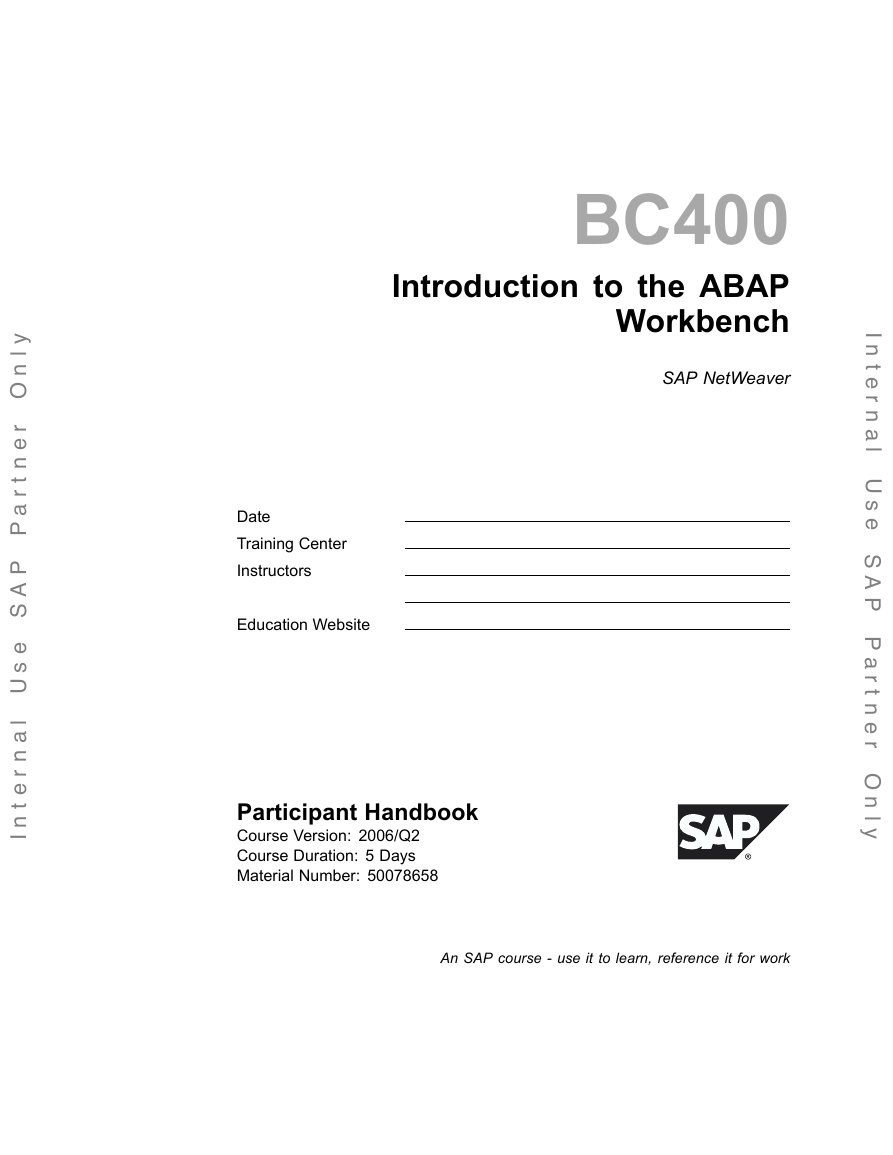
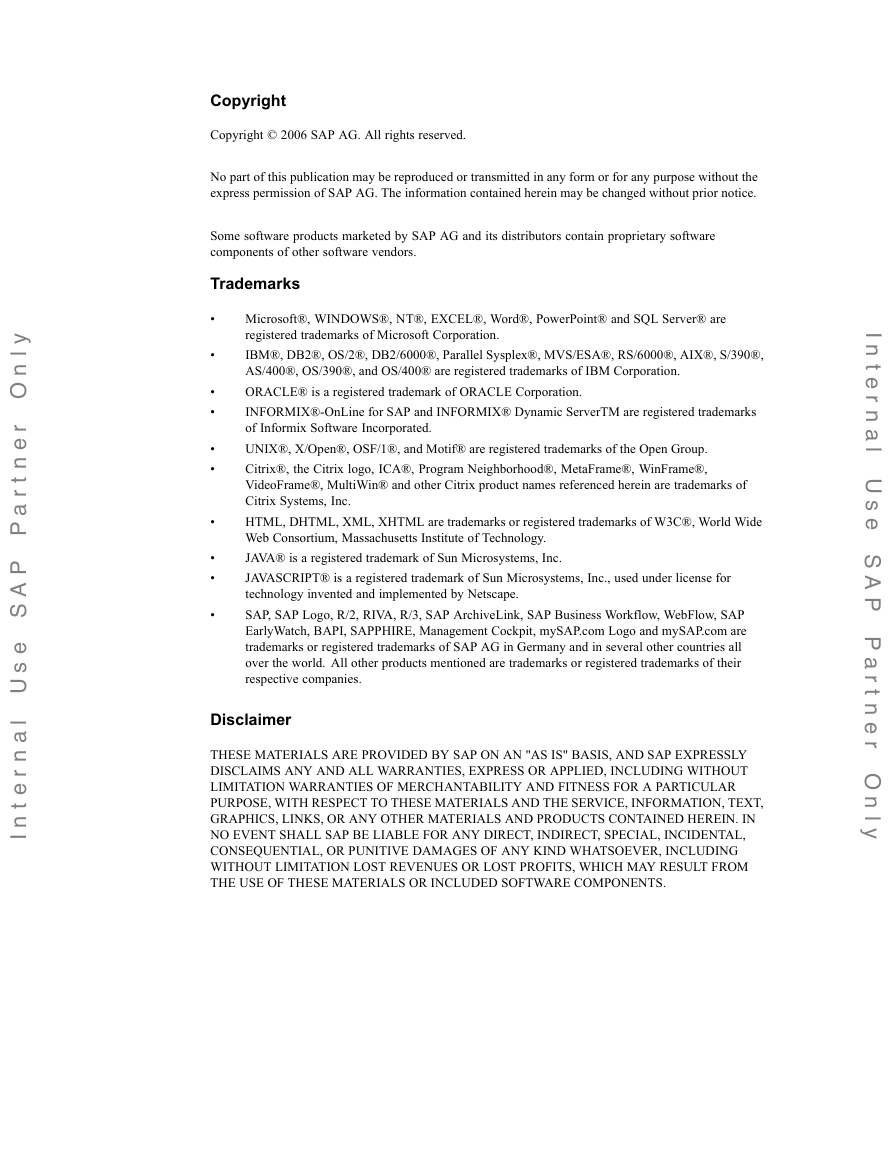

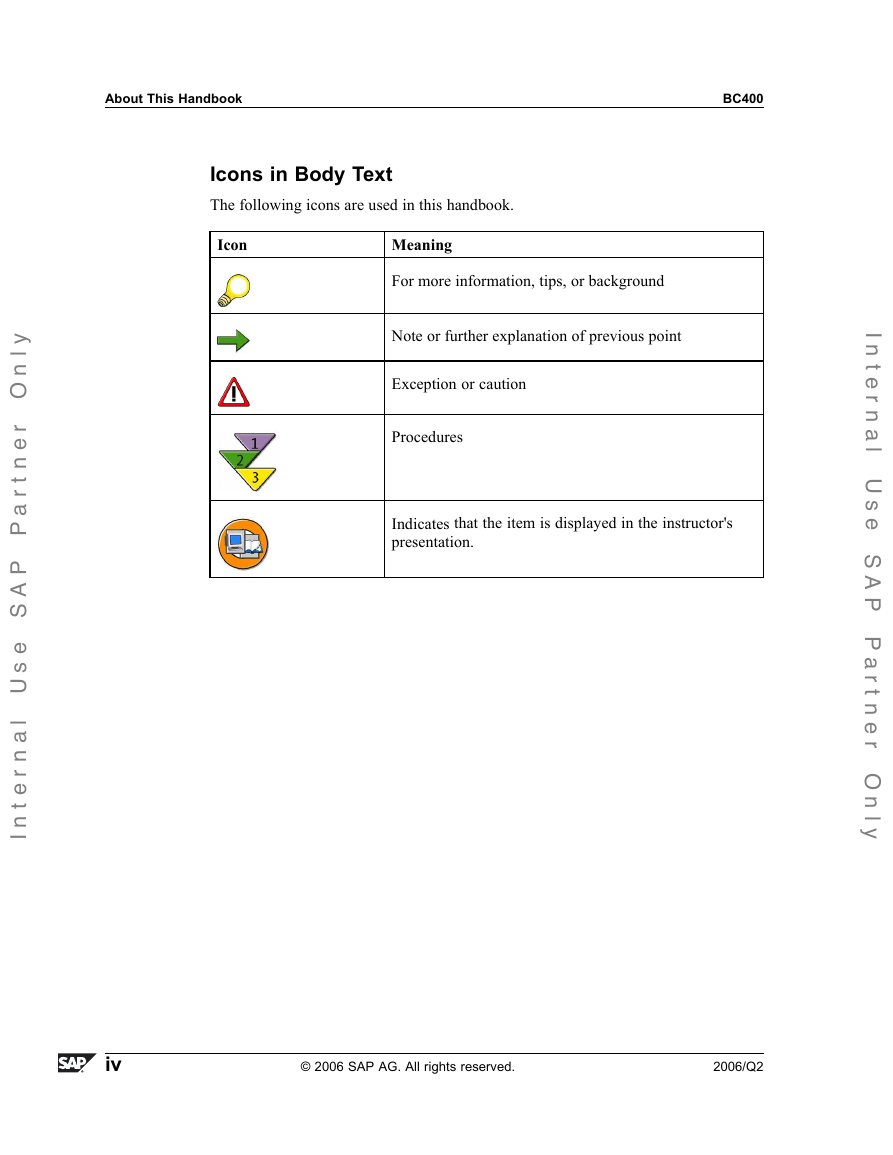
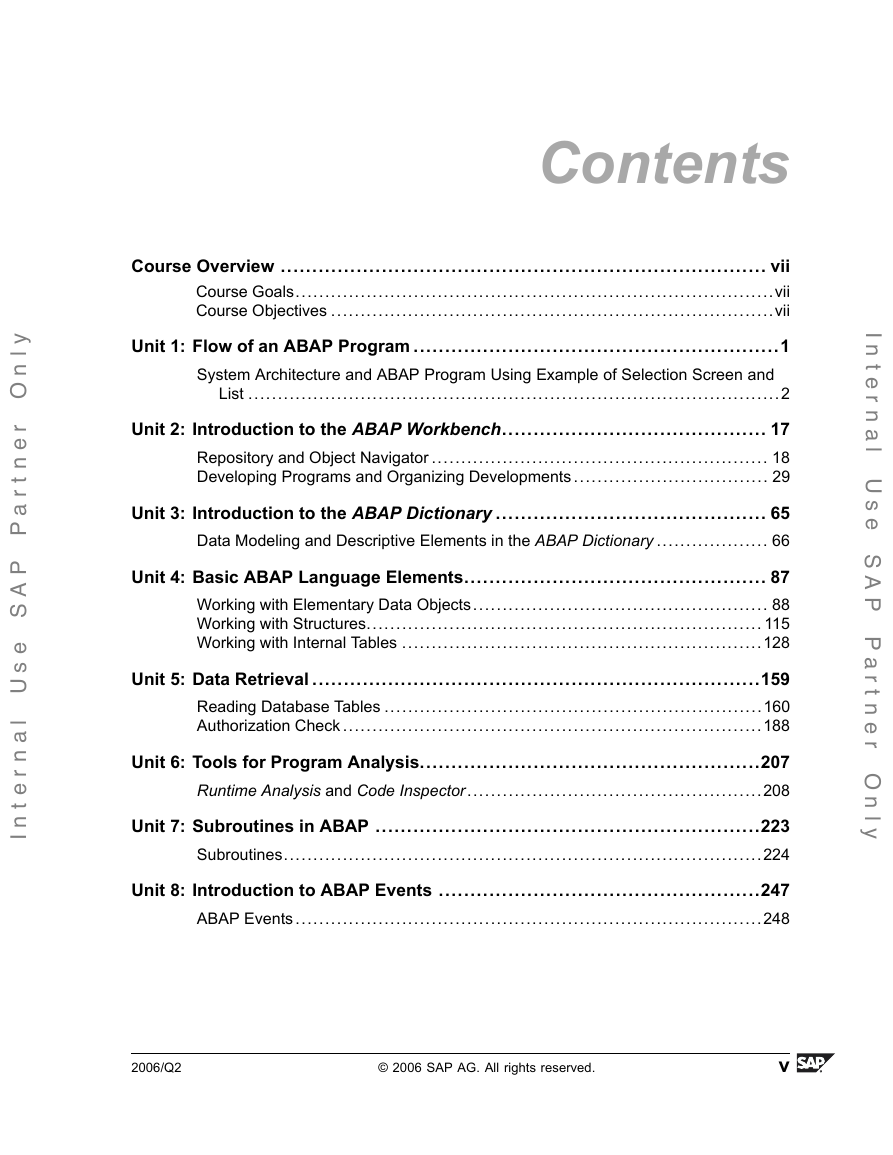
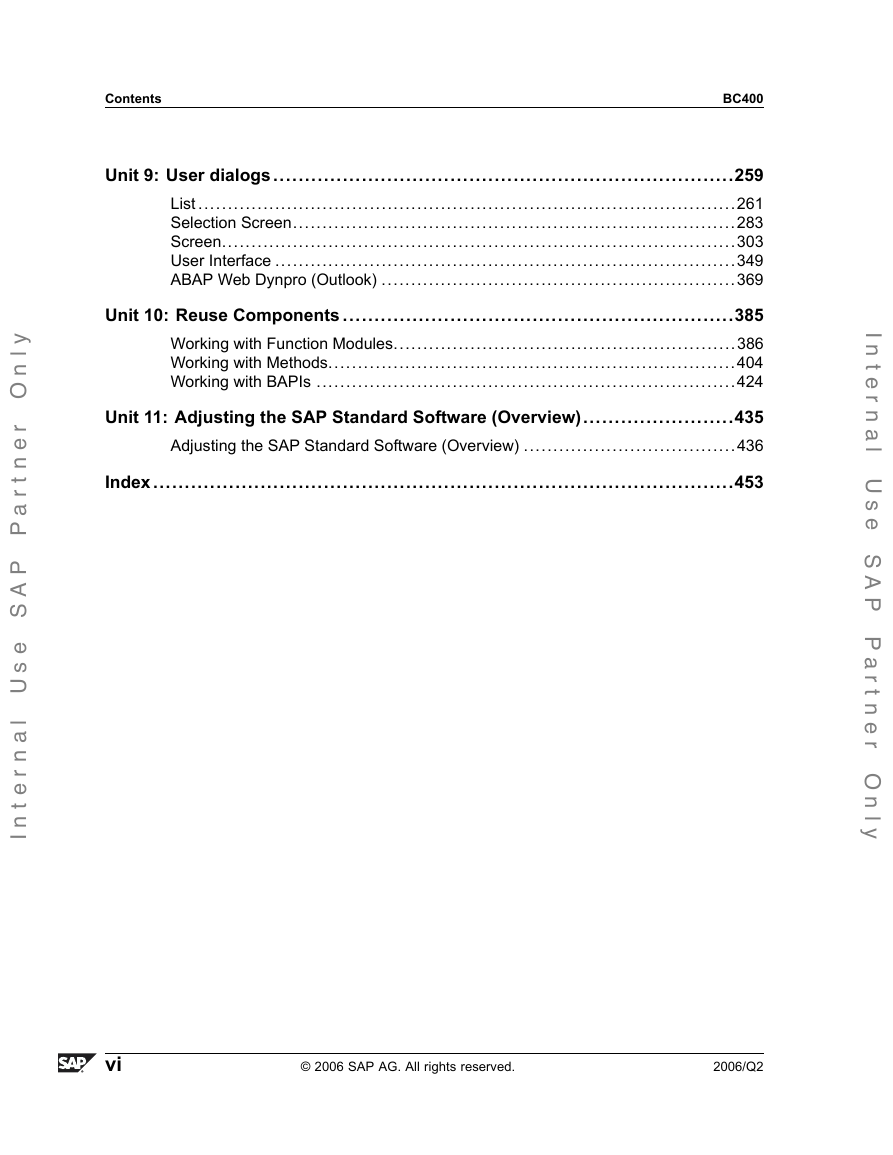
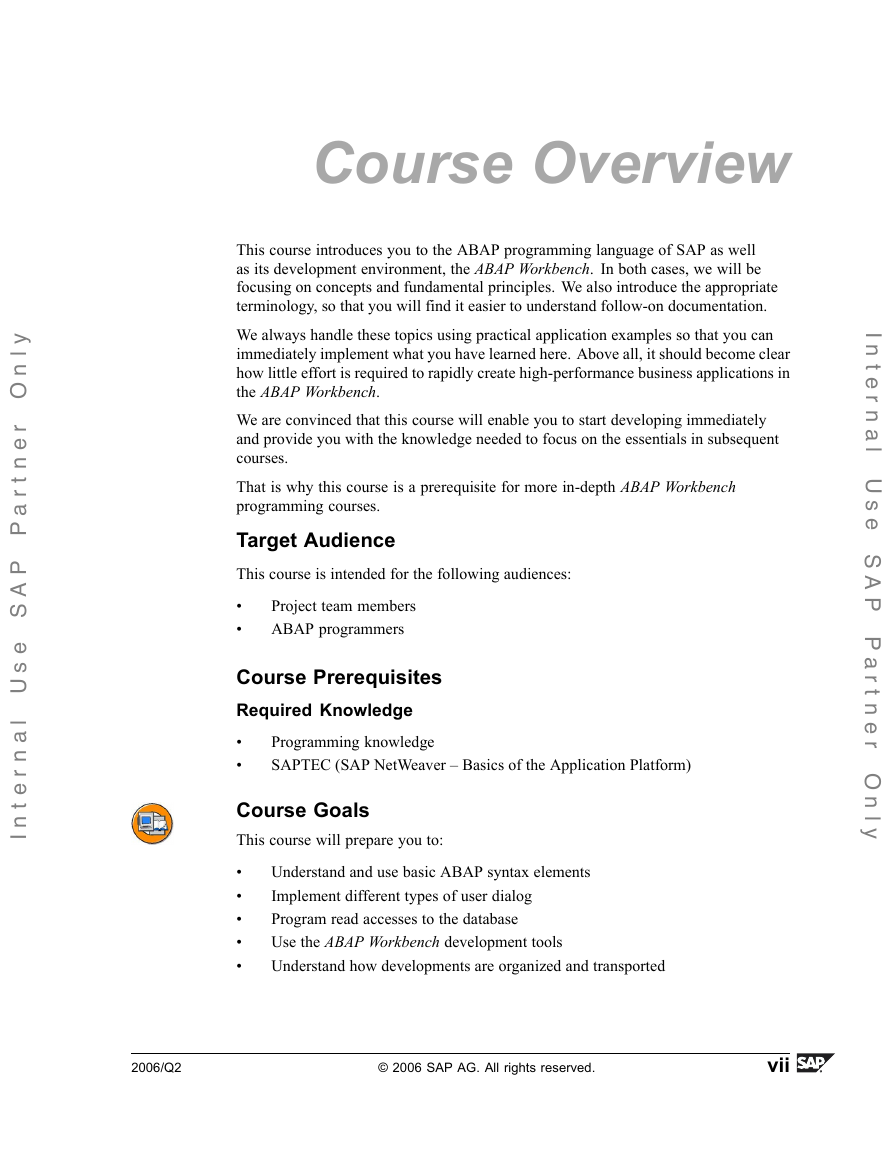
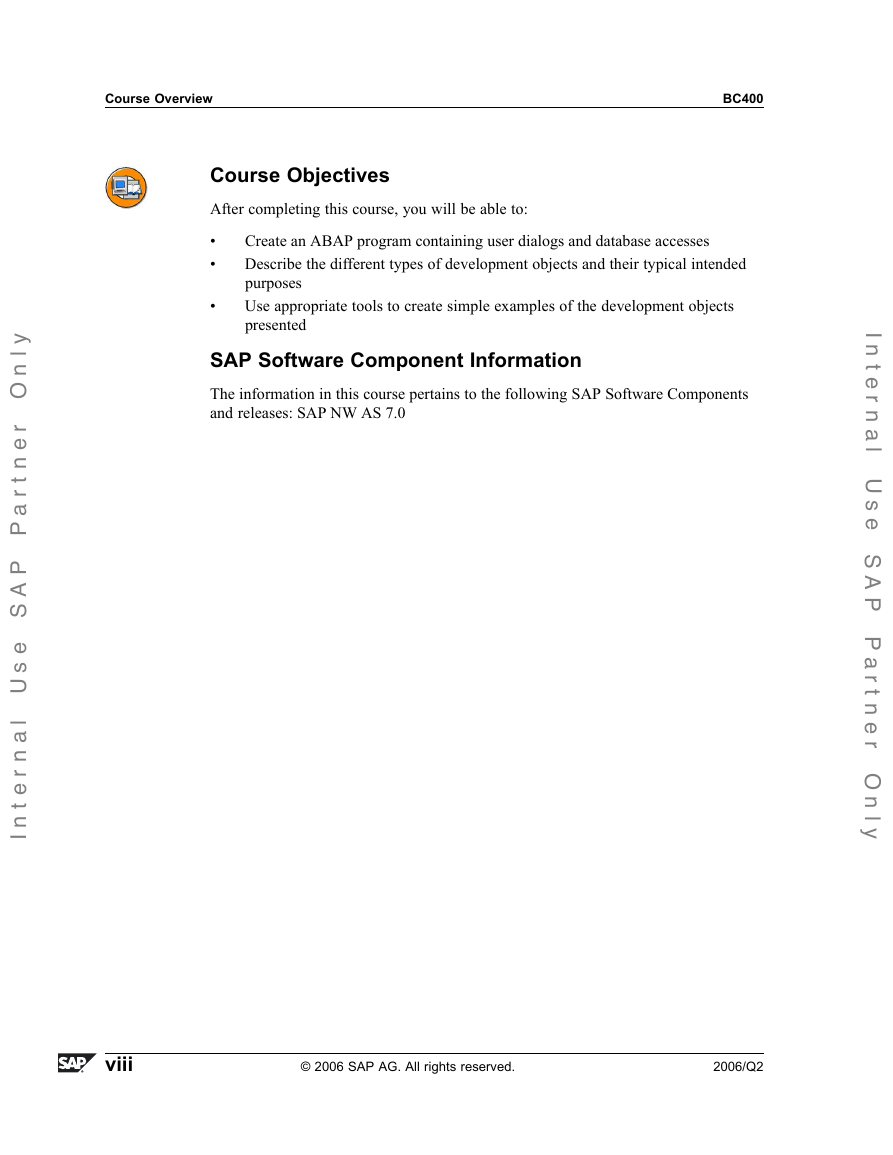








 2023年江西萍乡中考道德与法治真题及答案.doc
2023年江西萍乡中考道德与法治真题及答案.doc 2012年重庆南川中考生物真题及答案.doc
2012年重庆南川中考生物真题及答案.doc 2013年江西师范大学地理学综合及文艺理论基础考研真题.doc
2013年江西师范大学地理学综合及文艺理论基础考研真题.doc 2020年四川甘孜小升初语文真题及答案I卷.doc
2020年四川甘孜小升初语文真题及答案I卷.doc 2020年注册岩土工程师专业基础考试真题及答案.doc
2020年注册岩土工程师专业基础考试真题及答案.doc 2023-2024学年福建省厦门市九年级上学期数学月考试题及答案.doc
2023-2024学年福建省厦门市九年级上学期数学月考试题及答案.doc 2021-2022学年辽宁省沈阳市大东区九年级上学期语文期末试题及答案.doc
2021-2022学年辽宁省沈阳市大东区九年级上学期语文期末试题及答案.doc 2022-2023学年北京东城区初三第一学期物理期末试卷及答案.doc
2022-2023学年北京东城区初三第一学期物理期末试卷及答案.doc 2018上半年江西教师资格初中地理学科知识与教学能力真题及答案.doc
2018上半年江西教师资格初中地理学科知识与教学能力真题及答案.doc 2012年河北国家公务员申论考试真题及答案-省级.doc
2012年河北国家公务员申论考试真题及答案-省级.doc 2020-2021学年江苏省扬州市江都区邵樊片九年级上学期数学第一次质量检测试题及答案.doc
2020-2021学年江苏省扬州市江都区邵樊片九年级上学期数学第一次质量检测试题及答案.doc 2022下半年黑龙江教师资格证中学综合素质真题及答案.doc
2022下半年黑龙江教师资格证中学综合素质真题及答案.doc